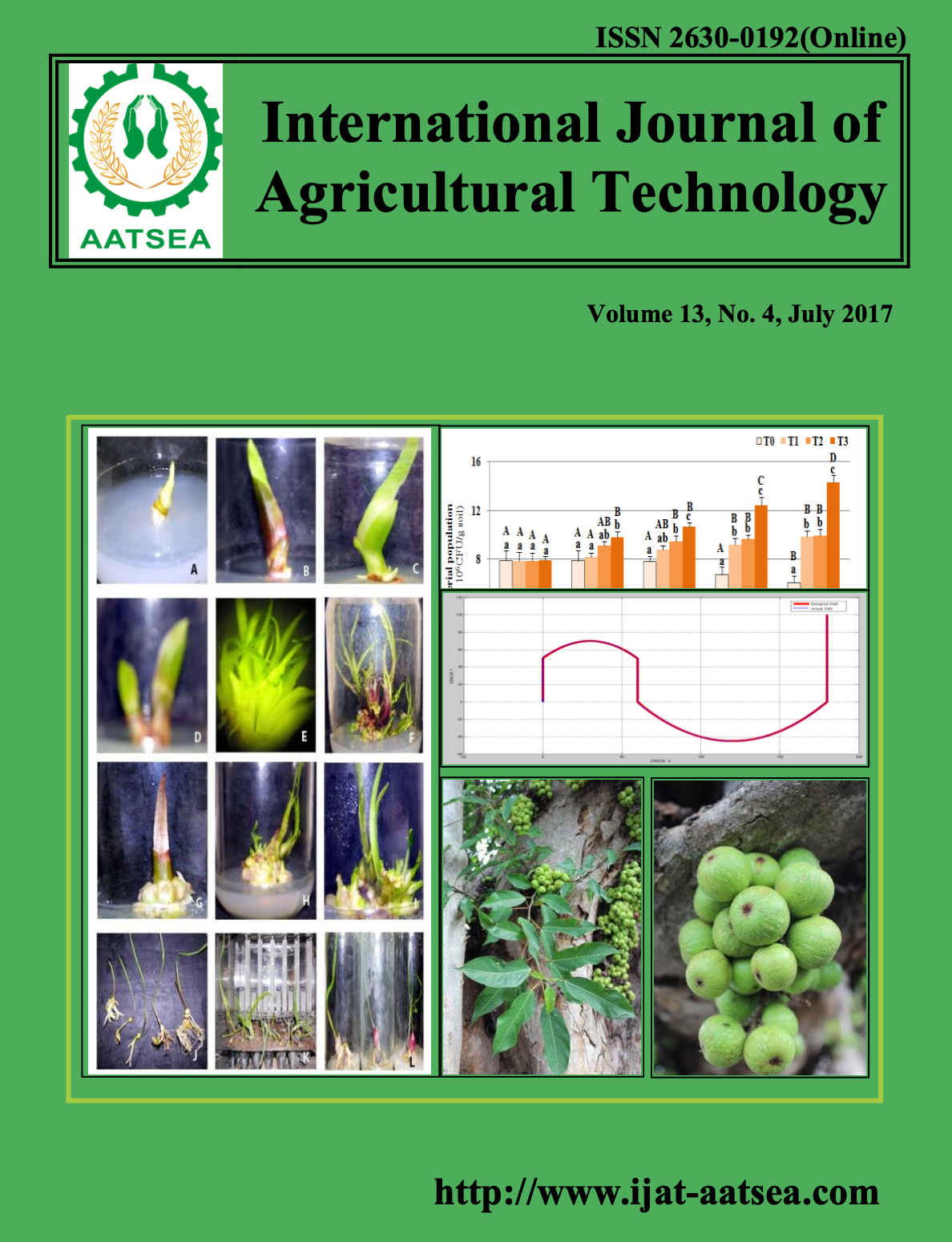Effects of microbial organic fertilizer and mulch to population and bioactivity of beneficial microorganisms in tea soil in Phu Tho, Viet Nam
Main Article Content
Abstract
Currently, tea in Phu Tho is grown in nutrient-poor and acidic soils, with pHKCl from 3.6 to 4.6, low total and digestible phosphate (P2O5); average organic matter (OM), potassium (K2O) and protein, low CEC (from 3.36 to 4.24 meq/ 100g soil), low Ca and Mg (from 2.75 to 3.27 meq/100g soil). Using microbial organic fertilizer at level of 3.0 tons per hectare influenced significantly both the population and composition of microorganism species in tea soil. Many soil microbes such as Pseudomonas, Bacillus, Azotobacter, Nitrosomonas and Nitrobacter which decompose organic matter, cellulose, insoluble phosphates have appeared in the soil as microbial organic fertilizers were provided. The filamentous fungi which are able to decompose insoluble phosphate, cellulose such as Aspergillus spp., Penicillium spp. Trichoderma spp. and Fusarium spp. have been detected. The total number of bacteria has increased rapidly in a short time as Guot (Gleichenia linearis Clarke) was used as mulch material. The number of bacteria reached to the highest level of 11.30 x 106 CFU/g (soil) after 180 days. Total numbers of actinomycetes have increased significantly. Many newly actinomycetes have appeared in the soil after 90 days of mulching, and continued to increase up to 11.05 x 106 CFU/g after 270 days. Fungi population also grew fast (from 5.35 x 103 CFU/g to 7.45 x 103 CFU/g) after 90 days of mulching then continue to rise sharply in the next 90 days and stabilized later. When using different materials, the percentage of microorganism groups that have bioactive are also different. Cellulose decomposing bacteria accounted for 40%, while the rate of bacteria that decompose insoluble phosphate made up for 44%.
Article Details

This work is licensed under a Creative Commons Attribution-NonCommercial-NoDerivatives 4.0 International License.
References
Araújo, A. S. F., Leite, L. F. C., Santos, V. B. and Carneiro, R. F. V. (2009). Soil microbial activity in conventional and organic agricultural systems. Sustainability. 1:268-276.
Dung, N. L. (1972). Some research methods of microbiology, volumes i, ii, iii, science and technology publishing house, Ha Noi.
Dung, N. L. (1978). Some research methods of microbiology, volumes i, ii, iii, science and technology publishing house, Ha Noi.
Dung, N. L. (1983). Apprenticeship of microbiology. Publisher of University and vocational schools - Ha Noi.
Egorov, N. S. (1983). Guide to practical training in microbiology. Moscow University. 220.
Fehmi, J. S. and Kong, T. M. (2012). Effects of soil type, rainfall, straw mulch, and fertilizer on semi-arid vegetation establishment, growth and diversity. Ecological Engineering 44:70-77.
Harris, R. W. (1992). Arboriculture: Integrated management of landscape trees, shrubs and vines. 2nd ed. Prentice Hall, Englewood Cliffs, NJ.
Helgason, B., Walley, F. and Germida, J. (2010). No-till soil management increases microbial biomass and alters community profiles in soil aggregates. Applied Soil Ecology. 46:390-397.
Maggard, A. O., Will, R. E., Hennessey, T. C., McKinley, C. R. and Cole, J. C. (2012). Tree-based mulches influence soil properties and plant growth. Horttechnology 22:353-361.
Mandic, L., Djukić D., Beatovic, Jovovic Z., Pesakovic M. and Stevovic V. (2011). Effect of different fertilizers on the microbial activity and productivity of soil under potato cultivation. African Journal of Biotechnology 10:6954-6960.
Muhammed, U. P. F. B. and Sindhu, P. V. (2015). Gopal, K. S. and George Thomas, C. Influence of mulches on rhizosphere microflora, yield and weed competition in okra [Abelmoschus esculentus (L.) Moench]. Journal of Tropical Agriculture 53:70-74.
Nakhro, N. and Dkhar, M. S. (2010). Impact of organic and inorganic fertilizers on microbial populations and biomass carbon in paddy field soil. Journal of Agronomy 9:102-110.
Ni, X., Song, W., Zhang, H., Yang, X. and Wang, L. (2016). Effects of mulching on soil properties and growth of tea olive (osmanthus fragrans). PLoS ONE. 11: e0158228.
Khue, P. V., Dung, N. V. and Thanh, N. X. (2016). Soil characteristics and soil quality database of agricultural land use types in Doan Hung District, Phu Tho Province. Vietnam Journal of the Science of Food and Agriculture 14:422-431.
Wu T., Chellemi, D. O., Graham, J. H., Martin, K. J. and Rosskopf, E. N. (2008). Comparison of soil bacterial communities under diverse agricultural land management and crop production practices. Microbial Ecology 55:293-310.
Yang, X., Li, Z. and Cheng, C. (2016). Effect of conservation tillage practices on soil phosphorus nutrition in an apple orchard. Horticultural Plant Journal. http://dx.doi.org/doi: 10.1016/j.hpj.
Zhen, Z., Liu, H., Wang, N., Guo, L. and Meng, J. (2014). Effects of manure compost application on soil microbial community diversity and soil microenvironments in a temperate cropland in China. PLoS ONE. 9: e108555.


